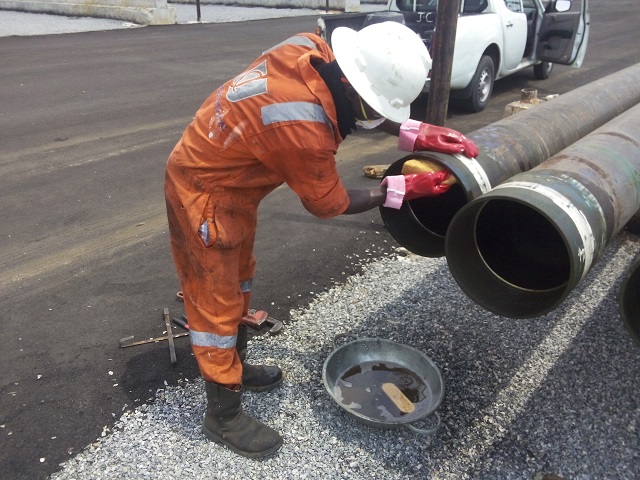
Proactive Stuck Pipe Preventive Measures You should know.

A stuck pipe poses a significant challenge to drilling operations, leading to costly downtime, equipment damage, and safety hazards. The hindrance it causes can be frustrating for workers striving to meet targets. Moreover, it imposes operational constraints and may incur financial burdens on organizations. Stuck pipe requires prompt intervention to resume drilling. Some proactive measures for stuck pipe prevention are shared in this blog post.
What is a stuck pipe?
In drilling, a stuck pipe refers to a situation where the movement or rotation of a pipe is frozen or restricted. When a pipe is stuck, the drill-string is rendered immobile and unable to twist, move up, or move down the wellbore.
Causes of Stuck Pipe.
Several factors contribute to stuck pipes, some of which can be mitigated through proactive measures. Below are common causes of stuck pipes during drilling:
1. Bridging: Bridging occurs when rock fragments, debris, or obstructions inadvertently or intentionally obstruct the drill hole. These particles or objects can impede the movement of the pipe, leading to a stuck pipe situation.
2. Wellbore Instability or Collapse: Wellbore instability refers to the undesirable condition of an open hole interval that fails to maintain its gauge size, shape, or structural integrity. Changes in size or shape can result in a stuck pipe. Borehole collapse happens when the pressure of the drilling fluid is insufficient to uphold the structural integrity of the drilled hole. Consequently, the collapse of the wellbore can lead to stuck pipes.
3. Drill String Design: The design of the drill string, which transmits the driving force from the rig on the surface to the drill bit at the well’s bottom, is crucial in drilling operations. Certain formations encountered during drilling can cause the drill string to become stuck, leading to a stuck pipe scenario. Monitoring torque and drag during drilling operations enables drilling engineers to detect when the drill string encounters harder formations, resulting in increased torque and drag.
Proactive Measures for stuck Pipe Prevention.
Preventing stuck pipes is essential for safe and efficient drilling operations in the oil and gas industry. Let us explore some measures that can safeguard drilling operations and enhance efficiency and safety.
1. Comprehensive Wellbore Analysis:
Before commencing drilling operations, conducting a thorough wellbore analysis is essential. This analysis should include assessing geological formations, pore pressure, and wellbore stability. By identifying potential hazards such as narrow pore pressure windows, high-pressure zones, or unstable formations, drilling teams can develop targeted strategies to mitigate the risks of stuck pipe incidents.
2. Real-Time Monitoring and Data Analysis:
Utilizing advanced drilling technologies to monitor drilling parameters in real-time is crucial for the early detection of potential stuck pipe conditions. Parameters such as torque, drag, mud weight, and rate of penetration should be continuously monitored and analyzed. Any deviations from expected values can indicate impending stuck pipe situations, prompting immediate corrective action.
3. Proper Mud Management:
Maintaining the proper properties of drilling mud is essential for preventing stuck pipe incidents. Mud weight, viscosity, and filtration properties must be carefully controlled to provide adequate wellbore support while minimizing the risk of differential sticking. Regularly conducting mud testing and making adjustments is necessary to ensure optimal performance under varying downhole conditions.
4. Effective Hole Cleaning Practices:
Inadequate hole cleaning can lead to the accumulation of cuttings, debris, and formation solids, increasing the risk of stuck pipe incidents. Implementing effective hole cleaning practices, such as optimizing drilling parameters, using appropriate mud flow rates, and deploying efficient bottom hole assembly (BHA) designs, can help prevent the buildup of debris and maintain wellbore integrity.
5. Proper Drill String and BHA Design:
The design and configuration of the drill string and bottom hole assembly (BHA) play a critical role in stuck pipe prevention. Selecting the right combination of drill pipe, drill collars, and stabilizers, as well as optimizing weight distribution and centralization, can minimize the risk of differential sticking and mechanical failures. Additionally, utilizing anti-sticking tools and devices, such as centralizers, can help reduce friction and improve wellbore stability.
6. Training and Competency Development:
Ensuring that drilling personnel adequately train and become competent in stuck pipe prevention techniques is paramount. Comprehensive training programs covering stuck pipe identification, mitigation strategies, and emergency response empower drilling crews to manage risks effectively and respond swiftly to adverse conditions.
JC International offers training on stuck pipe prevention in Lagos and Port Harcourt. Courses like this will equip drilling engineers with the adequate skills and proactive measures to prevent stuck pipe. We also offer other drilling and well intervention training programes in Lagos and Port Harcourt. Get started with us today to proactively prevent stuck pipes.

Leave a Reply